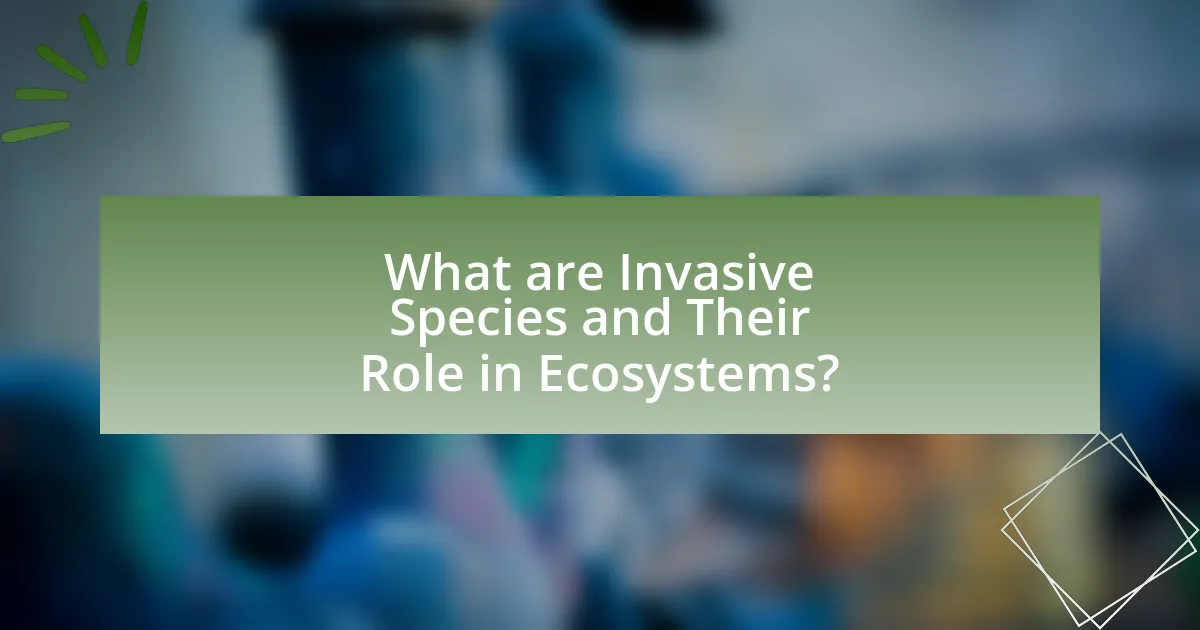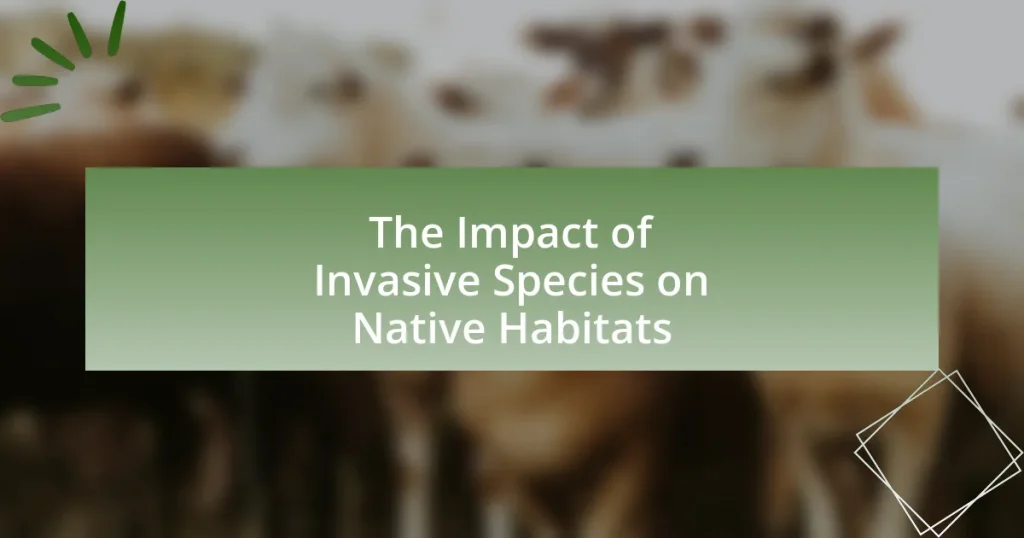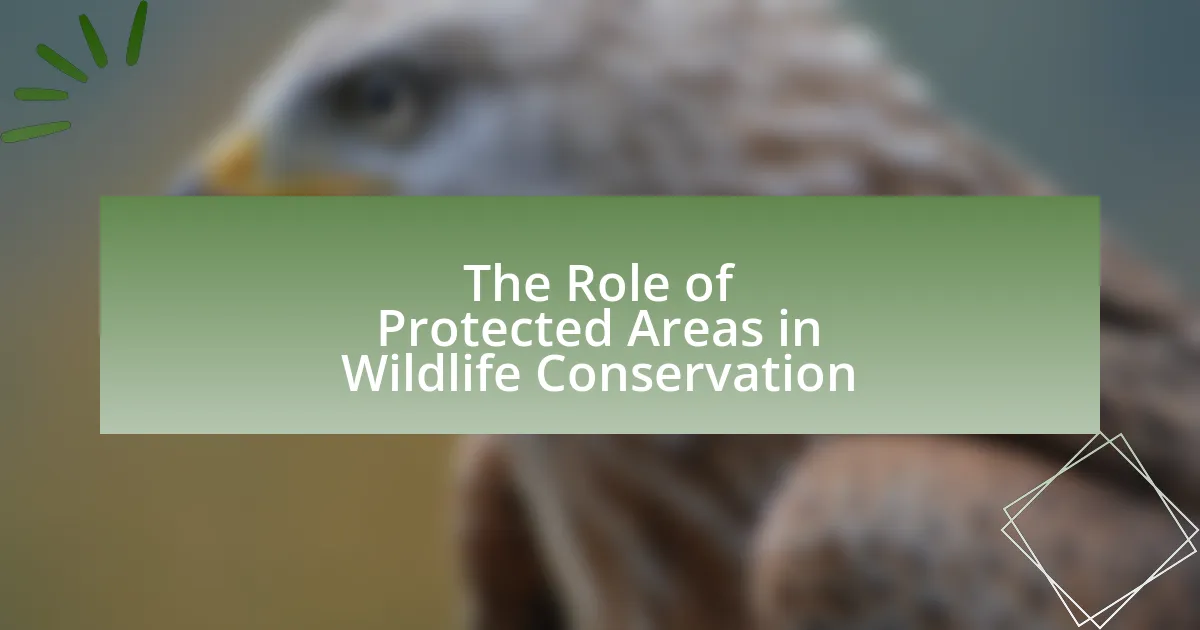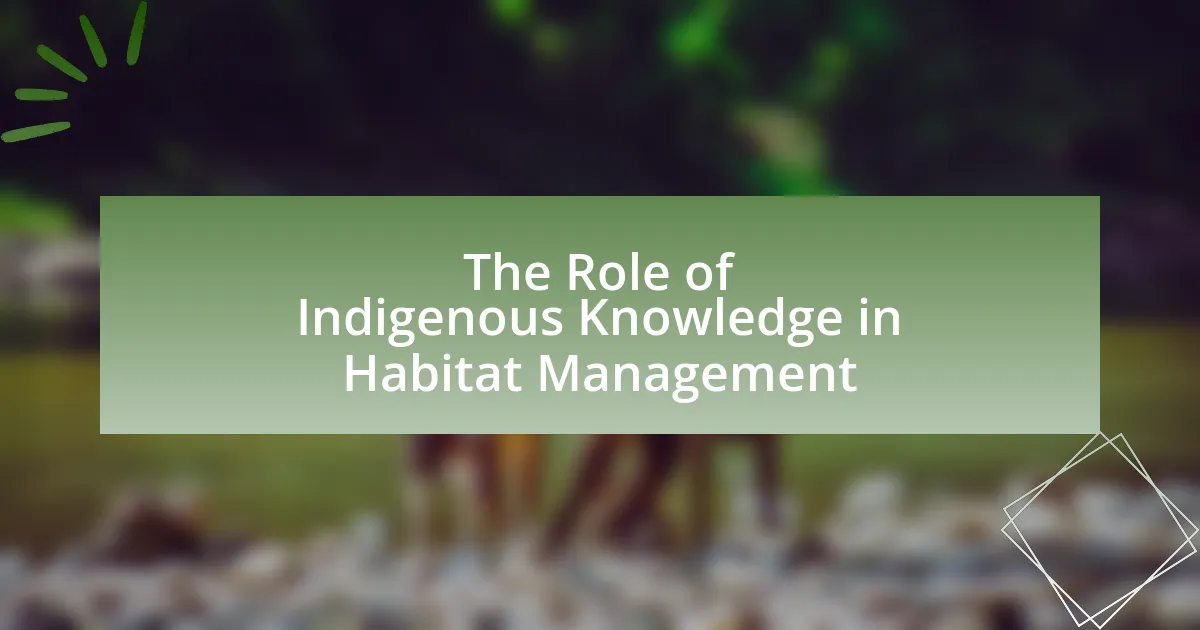Invasive species are non-native organisms that disrupt local ecosystems, outcompeting native species for resources and leading to declines in biodiversity. This article examines the characteristics of invasive species, their ecological and economic impacts, and the mechanisms through which they alter native habitats. It highlights the significant role invasive species play in reducing ecosystem resilience and biodiversity, as well as the strategies for managing their effects, including prevention, early detection, and community involvement in restoration efforts. Key examples, such as the zebra mussel, illustrate the profound consequences of invasive species on food webs and habitat structures.

What are Invasive Species and Their Role in Ecosystems?
Invasive species are non-native organisms that, when introduced to a new environment, disrupt local ecosystems and outcompete native species for resources. These species can alter habitat structure, nutrient cycling, and food webs, leading to declines in biodiversity. For example, the introduction of the zebra mussel in North America has resulted in significant ecological changes, including the displacement of native mussel species and alterations in aquatic food chains. Studies indicate that invasive species are responsible for approximately 40% of the extinctions of native species in the last century, highlighting their detrimental impact on ecosystems.
How do invasive species differ from native species?
Invasive species differ from native species primarily in their origin and ecological impact. Invasive species are organisms introduced to a new environment where they do not naturally occur, often leading to detrimental effects on local ecosystems, such as competition with native species for resources, predation, and habitat alteration. For example, the zebra mussel, introduced to North America from Europe, has caused significant ecological and economic harm by outcompeting native mussels and clogging water intake systems. In contrast, native species have evolved in their specific environments and are part of the local ecological balance, contributing to biodiversity and ecosystem stability.
What characteristics define an invasive species?
An invasive species is characterized by its ability to establish, spread, and cause harm to native ecosystems. These species often reproduce rapidly, outcompete native species for resources, and disrupt local food webs. For example, the zebra mussel, introduced to North America in the 1980s, has proliferated in freshwater systems, leading to significant ecological and economic impacts by outcompeting native mussels and clogging water intake systems. This demonstrates how invasive species can alter habitats and threaten biodiversity.
Why are some species more invasive than others?
Some species are more invasive than others due to their biological traits, adaptability, and the absence of natural predators in new environments. For instance, species like the zebra mussel can reproduce rapidly and thrive in diverse conditions, allowing them to outcompete native species for resources. Research indicates that invasive species often possess traits such as high reproductive rates, broad diets, and aggressive growth patterns, which enhance their ability to establish and spread in non-native habitats. A study published in “Ecological Applications” by K. A. McCarthy and colleagues highlights that invasive species often exploit ecological niches that native species cannot, leading to significant disruptions in local ecosystems.
What are the general impacts of invasive species on ecosystems?
Invasive species generally disrupt ecosystems by outcompeting native species for resources, altering habitat structures, and introducing diseases. These species often thrive in new environments due to a lack of natural predators, leading to declines in native biodiversity. For instance, the introduction of the zebra mussel in North America has resulted in significant declines of native mussel populations and altered aquatic ecosystems. Additionally, invasive plants can change soil chemistry and hydrology, further impacting native flora and fauna. The overall effect is a reduction in ecosystem resilience and functionality, which can have cascading effects on food webs and ecosystem services.
How do invasive species affect biodiversity?
Invasive species negatively affect biodiversity by outcompeting native species for resources, disrupting ecosystems, and altering habitat structures. For example, the introduction of the zebra mussel in North America has led to significant declines in native mussel populations, which are crucial for maintaining water quality and ecosystem balance. Studies indicate that invasive species can cause native species extinction, with estimates suggesting that they are responsible for approximately 42% of all endangered species in the United States. This evidence highlights the critical impact invasive species have on biodiversity and the overall health of ecosystems.
What are the economic implications of invasive species?
Invasive species have significant economic implications, including damage to agriculture, fisheries, and ecosystems, which can lead to substantial financial losses. For instance, the United States spends approximately $120 billion annually to manage invasive species and mitigate their impacts, according to the National Invasive Species Council. Additionally, invasive species can reduce crop yields and disrupt local fisheries, resulting in decreased income for farmers and fishermen. The economic burden also extends to increased costs for control measures and restoration efforts, further straining public resources and impacting local economies.

How do Invasive Species Specifically Impact Native Habitats?
Invasive species disrupt native habitats by outcompeting local flora and fauna for resources such as food, space, and light. This competition can lead to a decline in native species populations, altering ecosystem dynamics. For example, the introduction of the zebra mussel in North America has resulted in significant declines of native mussel species, with studies indicating that it can reduce native populations by up to 90%. Additionally, invasive species can introduce diseases and parasites that native species are not equipped to handle, further threatening their survival. The alteration of habitat structure, such as the spread of invasive plants that change soil chemistry or water availability, can also hinder the growth of native species, leading to a loss of biodiversity and ecosystem resilience.
What mechanisms do invasive species use to disrupt native habitats?
Invasive species disrupt native habitats primarily through competition, predation, and habitat alteration. Competition occurs when invasive species outcompete native species for resources such as food, light, and space, leading to declines in native populations. For example, the introduction of the zebra mussel in North America has significantly reduced populations of native mussels by competing for food and habitat. Predation by invasive species can also lead to the decline or extinction of native species; the brown tree snake in Guam has caused the extinction of several bird species by preying on them. Additionally, invasive species can alter habitats by changing nutrient cycling, hydrology, or physical structure, as seen with the introduction of the common reed, which can dominate wetlands and displace native vegetation. These mechanisms collectively threaten biodiversity and disrupt ecosystem functions.
How do invasive species compete with native species for resources?
Invasive species compete with native species for resources by exploiting the same ecological niches, leading to reduced availability of food, habitat, and other essential resources for native species. For instance, invasive plants can outgrow native vegetation, overshadowing them and limiting their access to sunlight, which is critical for photosynthesis. Additionally, invasive predators may consume native prey species, disrupting local food webs and diminishing native populations. Research has shown that invasive species can lead to a decline in biodiversity; for example, the introduction of the zebra mussel in North America has significantly impacted native mussel populations by outcompeting them for food and space.
What role do invasive species play in altering habitat structure?
Invasive species significantly alter habitat structure by outcompeting native species for resources, leading to changes in community composition and ecosystem functions. For example, the introduction of the zebra mussel in North American freshwater systems has resulted in decreased populations of native mussels and altered nutrient cycling, which impacts the entire aquatic ecosystem. Studies show that invasive plants can change soil chemistry and moisture levels, further affecting the native flora and fauna. This disruption can lead to reduced biodiversity and altered habitat characteristics, ultimately transforming the ecological balance of the affected areas.
What are the ecological consequences of invasive species on native habitats?
Invasive species disrupt native habitats by outcompeting local flora and fauna for resources, leading to declines in biodiversity. For instance, the introduction of the zebra mussel in North America has resulted in significant reductions of native mussel populations, altering aquatic ecosystems. Additionally, invasive plants like kudzu can dominate landscapes, smothering native vegetation and changing soil chemistry. These ecological shifts can destabilize food webs and reduce habitat quality, ultimately threatening the survival of native species.
How do invasive species affect food webs and trophic dynamics?
Invasive species disrupt food webs and trophic dynamics by altering species interactions and resource availability. These non-native organisms can outcompete native species for food and habitat, leading to declines in native populations. For example, the introduction of the zebra mussel in North America has significantly reduced populations of native mussels and altered the aquatic food web by filtering out large amounts of phytoplankton, which affects the entire ecosystem. Additionally, invasive predators can directly reduce the abundance of native prey species, further destabilizing trophic relationships. Studies have shown that invasive species can lead to a loss of biodiversity and changes in ecosystem functions, demonstrating their profound impact on food webs and trophic dynamics.
What are the long-term effects of invasive species on ecosystem resilience?
Invasive species significantly reduce ecosystem resilience over the long term by disrupting native species interactions and altering habitat structures. These species often outcompete native flora and fauna for resources, leading to declines in biodiversity. For instance, the introduction of the zebra mussel in North America has resulted in the decline of native mussel populations, which are crucial for water filtration and habitat stability. Additionally, invasive plants like kudzu can dominate landscapes, smothering native vegetation and altering soil chemistry, which further destabilizes ecosystems. Studies indicate that ecosystems with high levels of invasive species experience reduced ability to recover from disturbances, such as fires or floods, thereby diminishing their overall resilience.

What Strategies Can Be Implemented to Mitigate the Impact of Invasive Species?
To mitigate the impact of invasive species, strategies such as prevention, early detection, rapid response, and management are essential. Prevention involves implementing measures to stop invasive species from entering new environments, which can include stricter regulations on imports and public awareness campaigns. Early detection allows for the identification of invasive species before they establish, enabling timely interventions. Rapid response includes immediate actions to eradicate or control invasive populations upon detection, which can significantly reduce their spread. Management strategies, such as biological control, habitat restoration, and monitoring, help to manage existing invasive species and restore native ecosystems. For example, the use of specific predators or pathogens to control invasive species has been documented in various studies, demonstrating effective management outcomes.
How can early detection and rapid response help manage invasive species?
Early detection and rapid response are critical in managing invasive species as they significantly reduce the likelihood of establishment and spread. By identifying invasive species early, management efforts can be implemented before they proliferate, minimizing ecological and economic impacts. For instance, studies show that controlling invasive species within the first year of introduction can lead to a 90% reduction in their population, as demonstrated in the case of the zebra mussel in the Great Lakes. Rapid response strategies, such as immediate removal or targeted treatments, can effectively contain and mitigate the effects of invasive species on native habitats, preserving biodiversity and ecosystem integrity.
What are effective monitoring techniques for invasive species?
Effective monitoring techniques for invasive species include remote sensing, field surveys, and citizen science initiatives. Remote sensing utilizes satellite imagery and aerial photography to detect changes in land cover and identify potential invasive species spread, allowing for large-scale monitoring. Field surveys involve systematic sampling and observation in specific areas to assess the presence and abundance of invasive species, providing detailed data on their distribution. Citizen science initiatives engage the public in reporting sightings and collecting data, which can significantly enhance monitoring efforts by increasing the volume of information gathered. These techniques are validated by studies showing that integrated monitoring approaches improve detection rates and management outcomes for invasive species.
How can public awareness and education contribute to prevention?
Public awareness and education significantly contribute to the prevention of invasive species by informing communities about the risks and impacts associated with these species. Educated individuals are more likely to recognize invasive species, understand their ecological consequences, and adopt preventive measures, such as reporting sightings or avoiding the introduction of non-native species. For instance, a study by the U.S. Fish and Wildlife Service found that public outreach programs increased awareness and reporting of invasive species by 40%, demonstrating the effectiveness of education in fostering proactive behaviors.
What are some best practices for restoring native habitats affected by invasive species?
Best practices for restoring native habitats affected by invasive species include conducting thorough assessments of the ecosystem, implementing targeted removal of invasive species, and reintroducing native flora and fauna. Ecosystem assessments help identify the extent of invasion and the specific species involved, which is crucial for effective management. Targeted removal can involve mechanical, chemical, or biological methods tailored to the invasive species, ensuring minimal impact on native species. Reintroducing native species, supported by local ecological knowledge, fosters resilience and biodiversity in the restored habitat. Research indicates that these practices can significantly enhance the recovery of native ecosystems, as demonstrated in studies like “Restoration of Native Plant Communities in the Presence of Invasive Species” published in the journal Ecological Restoration.
How can habitat restoration techniques be tailored to combat invasives?
Habitat restoration techniques can be tailored to combat invasive species by implementing targeted removal strategies, enhancing native biodiversity, and restoring ecological processes. Targeted removal involves identifying and eradicating invasive species through methods such as mechanical removal, chemical treatments, or biological control, which have been shown to effectively reduce invasive populations (e.g., the use of herbicides to control invasive plants). Enhancing native biodiversity can be achieved by reintroducing native species that compete with invasives, thereby promoting a balanced ecosystem. Additionally, restoring ecological processes, such as soil health and hydrology, supports native species resilience against invasives. Research indicates that these tailored approaches can significantly improve the success of restoration efforts in areas affected by invasive species, as demonstrated in studies like the one conducted by Hobbs and Harris (2001) in “Restoration Ecology.”
What role does community involvement play in restoration efforts?
Community involvement is crucial in restoration efforts as it enhances local engagement, fosters stewardship, and ensures the sustainability of projects. When communities participate, they bring valuable local knowledge and resources, which can lead to more effective and culturally relevant restoration strategies. For instance, studies have shown that projects with community involvement are more likely to succeed; a report by the National Oceanic and Atmospheric Administration indicated that community-led initiatives in coastal restoration resulted in a 30% increase in project effectiveness compared to those without local engagement. This highlights the importance of community involvement in achieving long-term ecological goals and combating the impacts of invasive species on native habitats.
What practical steps can individuals take to reduce the impact of invasive species?
Individuals can reduce the impact of invasive species by actively participating in local conservation efforts, such as removing invasive plants from their gardens and reporting sightings of invasive species to local authorities. Engaging in community clean-up events helps prevent the spread of invasive species by removing debris that may harbor them. Additionally, individuals should educate themselves and others about the identification of invasive species, as awareness is crucial for early detection and management. According to the U.S. Fish and Wildlife Service, invasive species can cause significant ecological and economic harm, making individual actions vital in mitigating their effects.




